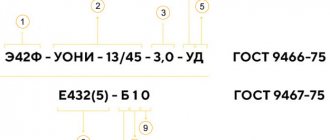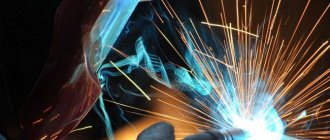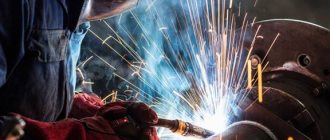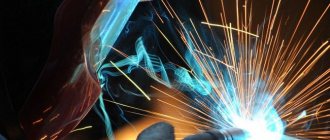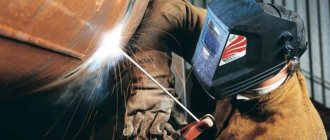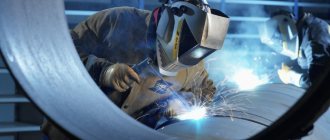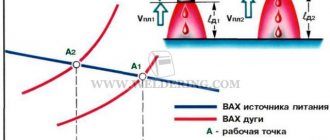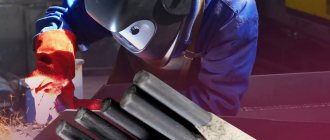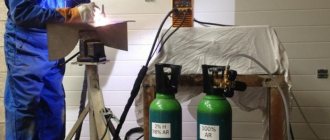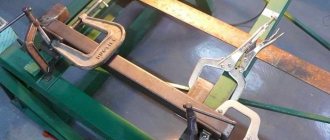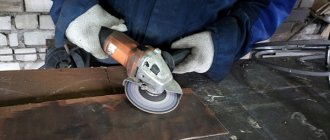The electrode is a metal or non-metallic rod coated with a coating. This material is an important component for welding work. The most relevant classification is the division of consumables into brands. Due to the presence of similar properties, there is a distinction between types, each of which has its own purpose of use. In this article we will look at the details about welding electrodes: description and characteristics that directly affect welding work.
Types and purpose of welding electrodes
With welding you can:
- connect metal parts;
- manufacture metal structures of any size;
- cut metal;
- eliminate cracks;
- cut round and shaped holes;
- weld metal to restore wear areas;
- carry out repairs and other types of work.
The industry produces many types of electrodes, about two hundred of them. Each of them is most effective within the limited characteristics of these works, so the choice of electrodes for welding is a very important step. It should be done after thoroughly studying the topic or with the help of specialists.
The criteria for selecting electrodes are the design parameters, characteristics and purpose specified by the product manufacturer. The main ones are:
- electrode brand;
- appointment;
- core diameter;
- type of electrode coating;
- electrode length;
- the magnitude of the working current;
- type of current and polarity of connection;
- composition of the central rod;
- welding position;
- special technological characteristics of the welding process.
Manual arc welding technique
Electrode trajectory
- Proper arc maintenance and movement is the key to quality welding. An arc that is too long promotes oxidation and nitriding of the molten metal, spatters its droplets and creates a porous weld structure. A beautiful, even and high-quality seam is obtained with the correct choice of arc and its uniform movement, which can occur in three main directions.
- The forward movement of the welding arc occurs along the axis of the electrode. With this movement, the required arc length is maintained, which depends on the melting rate of the electrode. As the electrode melts, its length decreases, and the distance between the electrode and the weld pool increases. To prevent this from happening, the electrode should be moved along the axis, maintaining a constant arc. It is very important to maintain synchronicity. That is, the electrode moves towards the weld pool synchronously with its shortening.
- The longitudinal movement of the electrode along the axis of the welded seam forms a so-called thread welding bead, the thickness of which depends on the thickness of the electrode and the speed of its movement. Typically, the width of the thread welding bead is 2 - 3 mm larger than the diameter of the electrode. Strictly speaking, this is already a welding seam, only a narrow one. For a strong welding joint, this seam is not enough. And therefore, as the electrode moves along the axis of the weld, a third movement is performed, directed across the weld.
- The transverse movement of the electrode allows you to obtain the required seam width. It is performed by oscillatory movements of a reciprocating nature. The width of the transverse vibrations of the electrode is determined in each case individually and largely depends on the properties of the materials being welded, the size and position of the seam, the shape of the groove and the requirements for the welded joint. Typically, the width of the seam lies in the range of 1.5 - 5.0 electrode diameters.
- Thus, all three movements overlap each other, creating a complex trajectory of the electrode. Almost every experienced craftsman has his own skills in choosing the trajectory of the electrode, drawing intricate shapes with its end. Classic trajectories of electrode movement during manual arc welding are shown in Fig. 1. But in any case, the arc movement trajectory should be chosen in such a way that the edges of the parts being welded are fused to form the required amount of deposited metal and the specified weld shape.
- If the weld is not completed before the length of the electrode decreases so much that it requires replacement, then welding is stopped for a while. After replacing the electrode, remove the slag and resume welding. To complete a broken seam, strike an arc at a distance of 12 mm from the depression formed at the end of the seam, called a crater. The electrode is returned to the crater to form a fusion of the old and new electrodes, and then the electrode begins to move again along the originally chosen path.
Arc welding diagram
- The order of filling the seam along the cross-section and length determines the ability of the welded joint to absorb given loads and affects the magnitude of internal stresses and deformations in the seam mass.
- Seams are distinguished: short - the length of which does not exceed 300 mm, medium - 300 - 100 mm long and long - over 1000 mm. Depending on the length of the seam, its filling can be carried out according to various welding filling schemes, which are presented in Fig. 2.
- In this case, short seams are filled in one pass - from the beginning of the seam to its end. Medium-length seams can be filled using the reverse-step method or from the middle to the ends. To perform the reverse-step filling method, the seam is divided into sections whose length is 100-300 mm. In each of these sections, the seam is filled in the direction opposite to the general welding direction.
- If one pass of the welding arc is not enough to fill the seam normally, multilayer seams are applied. Moreover, if the number of applied layers is equal to the number of passes, the seam is called multilayer. If some layers are performed in several passes, such seams are called multi-layer-pass. Such seams are shown schematically in Fig. 3.
| Rice. 2. Arc welding schemes: 1 - pass welding; 2 - welding from the middle to the edges; 3 - reverse-step welding; 4 - block welding; 5 - cascade welding; 6 - welding with a slide | Rice. 3. Types of welds: 1 - single-layer; 2 - multi-pass; 3 - multi-layer, multi-pass |
- From the point of view of labor productivity, the most appropriate are single-pass welds, which are preferred when welding metals of small (up to 8-10 mm) thicknesses with preliminary cutting of the edges.
- But for critical structures (pressure vessels, load-bearing structures, etc.) this is not enough. Internal stresses arising during the welding process can cause cracks to appear in the weld or in the heat-affected zone due to insufficient ductility of the weld and high rigidity of the base metal. When welding products with relatively low rigidity, internal stresses cause local or general warping (deformation) of the structure being welded. In addition, when welding metals with a thickness of more than 10 mm. volumetric stresses appear and the risk of cracks increases. In such cases, a number of measures are taken to reduce stress and deformation: welds of a minimum cross-section, welding with multilayer seams, seams using “cascade methods” or “slide”, forced cooling or heating are used.
- When welding “slide”, first a first layer is laid at the base of the cut edges, the length of which should be no more than 200 - 300 mm. After this, the first layer is covered with a second one, the length of which is 200 - 300 mm longer than the first. The third layer is applied in the same way, overlapping the second by 200 - 300 mm. In this way, filling is continued until the number of layers in the area of the first seam is sufficient for filling. The next layer is applied at the end of the first layer, overlapping the last one (if the length of the seam allows) by the same 200 - 300 mm. If the first seam was laid not at the beginning of the seam, but in its middle part, then the slide is formed sequentially in both directions (Fig. 2, f). So, forming a slide, the entire seam is sequentially filled. The advantage of this method is that the welding zone is in a heated state all the time, which helps to improve the physical and mechanical properties of the seam, since internal stresses are minimal and the appearance of cracks is prevented.
- The “cascade method” of filling a seam is essentially the same “slide”, but it is performed in a slightly different sequence. To do this, the parts are connected to each other “on tacks” or in special devices. Lay the first layer, and then, stepping back from the first layer at a distance of 200 - 300 mm, lay the second layer, covering the area of the first (Fig. 2, e). Continuing in the same sequence, fill the entire seam.
- Fillet welds (Fig. 4) can be performed using two methods, each of which has its own advantages and disadvantages. When welding “in the corner,” a larger gap between parts is allowed (up to 3 mm), assembly is easier, but the welding technique is more complicated. In addition, undercuts and sagging are possible, and productivity is reduced due to the need to weld small-section seams with a leg less than 8 mm in one pass. Boat welding allows for larger seam legs in one pass and is therefore more productive. However, such welding requires careful assembly.
- The indicated arc welding techniques were considered at the lower positions of the seam, the implementation of which is the least labor-intensive. In practice, it is often necessary to perform horizontal seams on a vertical plane, vertical and ceiling welding. To perform these works, the same techniques are used as for seams with a lower position, but the labor intensity of the work and some technological features require a more detailed approach and changes in some methods.
- When welding such seams, there is a possibility of molten metal leaking out, which leads to drops falling to areas unfilled by welding, molten metal flowing along horizontal planes, etc.
| Rice. 4. Position of the electrode and the product when making fillet welds: A - symmetrical boat welding; B - in an asymmetrical “boat”; B - “in the corner” with an inclined electrode; G - with melted edges | Rice. 5. The influence of welding speed on the shape of the weld: With increasing speed, a noticeable decrease in the width of the weld is observed, while the depth of penetration remains almost unchanged. |
- Considering the essence of the processes occurring in such seams, we said that surface tension forces can hold the metal in a molten bath. In order for these forces to be sufficient, the welder must be masterful in welding techniques. Here it is necessary to reduce the welding current and use electrodes of reduced cross-section. This ultimately affects productivity as the number of welding passes has to be increased. Therefore, in practice, they try to add a “surface tension film” in addition to surface tension forces. The essence of this method is that the arc is not held constantly, but at certain intervals, that is, pulses.
- To do this, the arc is constantly interrupted, igniting it at certain intervals, allowing the molten metal to partially crystallize. It is here that the welder’s ability to choose such intervals is manifested when the welding leg does not have time to form and at the same time the metal would lose part of its fluidity.
- The ceiling seam is the most difficult. Therefore, conducting it with continuous arc burning is a futile task. Welding is performed by short-circuiting the arc to the weld pool so that it does not have time to cool, replenishing it with new portions of molten metal.
- When welding with this method, you should monitor the size of the arc, since its lengthening can cause unwanted undercuts. In addition, when welding such seams, unfavorable conditions are created for the release of slag from the molten metal, which can lead to porosity of the weld.
- Vertical seams can be welded in two directions - from bottom to top and from top to bottom. Both methods have a right to exist, but uphill welding is always preferable. In this case, the metal located below holds the weld pool, preventing it from spreading.
- When welding downhill, it is more difficult to hold the weld pool, and therefore it is much more difficult to achieve a high-quality seam. The essence of this method is practically no different from ceiling welding, and it is used when upward welding is technologically impossible.
- Horizontal seams on a vertical plane also have their own characteristics. In these welds, it is particularly difficult to retain the weld pool at both edges of the parts being welded. To facilitate this process, the bottom edge is not beveled. In this case, a shelf is obtained that helps hold the molten weld pool in place. Pulse welding with short-term ignition of the arc is also appropriate here, as for ceiling seams.
- Welding slag is removed with a chipping hammer. To do this, wait until the workpiece has cooled down enough that it can be picked up by hand, press it firmly to the table and, with hammer blows directed along the seam, remove the slag covering the weld seam. After this, the seam is forged to relieve internal stress. To do this, the hammer head is deployed along the seam and forged along its entire length. Finish the cleaning with a stiff wire brush, moving it with sharp movements, first along the seam and then across it to remove the last remnants of slag.
| Rice. 6. The influence of the angle of inclination of the product on the shape of the weld: When welding uphill, a large depth of penetration is observed, as well as a large height of the bead. When welding downhill, on the contrary, the depth of penetration decreases and the height of the weld decreases. In this case, the width of the seam practically does not change. | Rice. 7. Influence of the position of the electrode on the shape of the weld: The figure shows that when welding with a backward angle, the penetration is deeper, and when welding with a forward angle, the width of the seam increases and the height of the bead decreases. |
| Rice. 8. The influence of welding speed on the shape of the weld: The position of the weld pool when the product, arc or electrode is tilted. Downhill welding, uphill welding, forward angle welding. | Rice. 9. The influence of preparing edges for welding in butt joints. |
| Rice. 10. Elements of a butt weld, fillet weld and bead on a plate: B - width of the weld; K - seam leg | Rice. 11. Influence of the welding current during welding: If the welding current is changed during welding, the parameters of the weld cross-section will change. At a lower current, the penetration depth increases and the weld bead increases. |
Purpose
The brand of the electrode, as a rule, encrypts its purpose. For example, product types:
- UONI - designed for welding parts at low temperatures;
- ANO-21 - for performing work with thin (up to 4 mm) parts operated under low pressure;
- MP-3S - for welding rolled parts and medium-carbon steels up to 20 mm thick;
- LEZ - for surfacing worn parts;
- inexpensive universal-use OZS-12 electrodes are recommended for welding carbon steels and are easy to use;
- rutile products of the ANO-4 grade are used for welding low-alloy and low-carbon steels; work on both direct and alternating currents; They cook metal contaminated with rust well, have a stable arc, and are easily cleaned of slag.
Experts distinguish between electrodes for welding, tacking, surfacing and cutting. Universal products are in great demand, saving a lot of time when performing various types of work.
Welding electrode sizes
You can currently find many types of electrodes on the market, which differ in the materials used for their manufacture and their sizes. Such welding rods for joining metals can be produced in various sizes. When choosing certain varieties of such surfacing materials, it is necessary to take into account their diameter, length, basic composition and type of coating. We will tell you in more detail how to choose the right length and diameter of the electrodes used.
Choosing the right diameter
The diameter of the rods, along with the composition of their alloy, is one of the most important parameters, therefore, when choosing one or another variety, you need to correctly determine the size you need, which will be the key to high-quality welding work. The thickness of the rod directly depends on the size of the base material. So, for example, if you need to weld metal sheets several millimeters thick, then you should choose electrodes that are small in size. If you are connecting metal parts with a thickness of several centimeters, and the depth of the seam will approach ten millimeters, then it is necessary to appropriately use thick surfacing rods for this work, which will ensure the strength of the connection. This characteristic is also influenced by the power indicator of the welding transformer. Different metals can differ significantly in their melting point, so it is necessary to correctly select the sizes of the surfacing materials used.
With the right choice, the melting temperature of the base surfacing material will be the same, which will allow both the electrodes and the base material to melt simultaneously. Consequently, the connecting seam will be uniform, high quality and durable. At the same time, you must understand that powerful transformers with high operating currents can instantly melt electrodes whose diameter is 2-3 millimeters.
If the diameter is chosen incorrectly, this can lead to a significant deterioration in the quality of the connection. If melting requires high power and high temperature, this can lead to the appearance of through holes in thin metal sheets. That is why it is necessary to correlate the thickness of the surfacing rods used with the characteristics of the base metals and their sizes.
Selecting the length of the electrodes
The length of the electrodes is not such a significant parameter for welding, however, in certain situations, the wrong choice can lead to a significant deterioration in the quality of the welding work performed. The length of the electrode depends on its thickness and the characteristics of the elements being welded. It must be understood that during the welding process, any interruption in the temperature treatment of the joint invariably leads to significant deterioration of the weld. Therefore, it will be necessary to select sizes of surfacing materials that will minimize or completely eliminate such welding interruptions, which will improve the quality of the work performed.
Short electrodes can be used in cases where long seams are not required. In this case, rods of 10 centimeters will be sufficient. But if you need to weld parts 30 centimeters or more in size, you need to choose electrodes that are appropriate in size, which will allow you to complete this work without interrupting welding. Please note that you should not purchase excessively long electrodes if you need to make short connections. In this case, if the length of the rods is chosen incorrectly, there is a risk of their breaking, which in turn leads to shedding of the coating, and without it the quality of the connection deteriorates significantly.
Currently, electrodes of various sizes can be found on sale. These can be either standard rods 10-15 centimeters long, or special varieties 30-40 centimeters or more long. It must be remembered that not all brands of electrodes are manufactured with a full range of sizes, which leads to some difficulties when choosing such a surfacing material.
Diameter and length of common varieties
- LB-52U. The manufacturer produces these brands with a diameter of 2.6 to 5 millimeters and a length of up to 35-40 centimeters.
- ANO-21. The length can be a maximum of 0.25-0.4 meters, with a diameter of 1.6-5 millimeters.
- MP3. This is a common type of surfacing rod and is available in a wide range. The diameter ranges from 2 to 5 millimeters, while their length reaches 45 centimeters.
- ANO-6. Buyers are offered three standard sizes, ranging from 3 to 5 millimeters. For electrodes with a diameter of 3 millimeters, the maximum length can be 35 centimeters. A five-millimeter surfacing rod has a maximum length of 45 centimeters.
Correct selection of electrodes
The diameter of the electrodes used for welding must be selected taking into account the thickness of the workpieces. In this case, the composition of the surfacing and base material should be as similar as possible, which will allow for a uniform, strong connection. It is also necessary to take into account the melting temperature of the parts being connected, which must be the same. In the event that metal products with a thickness of 1-3 millimeters are welded, then two-millimeter electrodes and an operating current of the inverter from 25 to 100 Amperes can be used. If you are welding parts with a thickness of 3 to 6 millimeters, then electrodes with a thickness of 3-4 millimeters can be used. The optimal operating current is 150-200 Amperes. Welding surfacing materials with a diameter of more than six millimeters can be used to weld metal with a thickness of 10 centimeters or more.
Important. Before starting welding, you should evaluate the condition of the coating, which should not be damaged, which can significantly deteriorate the quality of the weld.
The length of the electrode is important in cases where it is undesirable to interrupt the welding process, which can lead to a deterioration in the quality of the work performed. For example, when repairing sealed containers for high-pressure pipelines, interrupting the welding process and using several rods to weld one joint can lead to a significant decrease in reliability. As a result, expensive and complex repairs will be required in the future. There are also certain metal alloys for which interruption of welding will invariably lead to deterioration in the quality of the joint. That is why, when choosing the length, it is necessary to proceed from the length of the weld and select the rods in such a way that their size is larger than the weld.
By choosing the right welding rods, taking into account their length and thickness, you can ensure a high-quality connection, while the resulting seam will have the necessary decorative effect, mechanical strength, durability and corrosion protection.
svarkagid.com
Diameter
The choice of electrode (core) diameter is determined by the thickness of the parts being welded and the maximum current of the welding machine used. The higher they are, the thicker the connected elements can be.
All three parameters are dependent on each other. Their values are indicated in special tables, which are convenient to use before work and purchasing electrodes. So, for parts with a thickness of 3-4 mm, you need to use electrodes with a diameter of 3 mm with adjustable operating current within the range of 80-160 A.
By metal thickness
Electrodes for manual arc welding are manufactured in different diameters. The cross-section of the rod is indicated on the pack, and experienced welders are able to determine it by eye. The thickness of the coated electrode is selected based on the thickness of the sides to be welded and the current strength. If thick workpieces are welded with thin electrodes, the latter will overheat, which will lead to destruction of the coating, splashing of liquid metal, and excessive consumption of electrodes. Welding thin metal with a rod that is too thick will be of poor quality, since the electrode will create excessive current resistance, and it will not be possible to heat and melt the workpiece.
In the table we have given options for selecting the diameter of the electrode according to the current strength and thickness of the parts being welded.
| Metal thickness, mm | Electrode diameter, mm | Current strength, A |
| 1-2 | 1,6 | 25-55 |
| 2-3 | 2 | 40-80 |
| 3-4 | 3 | 80-160 |
| 4-6 | 4 | 120-200 |
| 6-8 | 5 | 180-250 |
| 10-20 | 6 | 220-320 |
Coating of electrodes
The core coating is a solid composition, a kind of flux, designed to protect the molten metal from the harmful effects of oxygen, which, when it enters the liquid metal, forms oxides that deteriorate the quality of the connection.
Another function of the coating is to thermally insulate the melt to delay the solidification time (so that harmful gas and non-metallic inclusions have time to escape from it). Modern electrodes use several types of coating. The main ones are basic (in the marking of electrodes, indicated by the letter “B”) and rutile (letter “R”).
Material and types of coating
The electrode coating, based on the ratio of the total diameter of the electrode to the diameter of the core, is divided into the following categories (coefficient):
- Type M – thin coating (up to 1.2).
- C – average (up to 1.45).
- D – thick (up to 1.8).
- G – especially thick (over 1.8).
There is also a separate classification based on composition:
- A – sour.
- B – basic.
- C – cellulose.
- R – rutile.
- Two letters (mentioned above, as well as rutile-iron with the designation RZH) are a mixed type.
- P – other types.
The given letters are involved in the marking.
NOTE:
There is an additional division of electrodes into several groups, depending on the condition of the coating and the accuracy of manufacturing of these products.
Color
Tungsten electrodes are separately color-coded, indicating the type and percentage weight of the oxide contained in the composition:
- Thorium – blue (0.35 – 0.55%), yellow (0.8 – 1.2%), red (1.7 – 2.2%), lilac (2.8 – 3.2%), orange (3.8 – 4.2%).
- Zirconium – brown (0.15 – 0.5%) and white (0.7 – 0.9%).
- Lanthanum oxide – black (0.9 – 1.2%), gold (1.4 – 1.6%), blue (1.8 – 2.2%).
- Cerium oxide – gray, corresponding to 1.8 – 2.2%.
Lilac and turquoise colors indicate mixed oxides consisting of rare earth elements. Green rods are made from pure tungsten.
Basic coating
It is known that it contains calcium salts - carbonate and fluoride. Its advantage is considered to be a low hydrogen content. Typical representatives of electrodes with basic coating are UONI products. Their coating ensures a high-quality seam, both in appearance and in technical indicators: ductility, strength, impact strength.
The electrodes do not form crystalline cracks inside the seam, therefore they are recommended by specialists for critical welding operations and for products operated in harsh climatic conditions. They can be used when welding in any position except vertical.
By type of metal being welded
It is necessary to select electrodes for RDS welding according to the type of metal being welded.
Then the composition of the rod will be as close as possible to the composition of the main product and the connection will be homogeneous. The likelihood of cracks or temperature deformations due to differences in linear expansion, thermal conductivity, and impact strength will be reduced. For example, when welding cast iron with mild steel electrodes, many pores are created as carbon escapes from the weld pool. Steel also cools faster than cast iron, so after welding, cracks along the seam are possible. The use of special electrodes, such as ESAB OK 92.58 NiFe-Cl-A, made of an iron-nickel alloy makes the connection more viscous and resistant to tearing.
Video source: Aurora Online Channel
Depending on the workpieces to be welded, select electrodes for:
- low-carbon and low-alloy steels;
- alloy steels (stainless steel);
- cast iron;
- high carbon steels;
- aluminum
Rutile coating
Rutile is titanium dioxide. In addition to it, the coating contains silicon and oxygen.
Rutile coating is characterized by the following properties:
- formation of a high-quality seam at any spatial position of the electrode;
- stable arc burning;
- minimal splashing of melt and coating;
- possibility of welding on both direct and alternating currents;
- possibility of welding rusty and dirty parts;
- quick and easy ignition of the electrode;
- easy removal of slag.
Popular brands
For a number of reasons, some electrodes have become popular among professionals and amateurs.
Causes:
- Special quality of materials.
- Low cost per kilogram.
- Availability in most regions.
Expert opinion
Levin Dmitry Konstantinovich
But to obtain high-quality seams, it is recommended to choose electrodes that can be used to ensure a reliable connection of the starting materials.
Uoni-13/55
Electrodes are produced by a number of factories in Russia and CIS countries. Designed to work with low-carbon, low-alloy steels, and some grades of cast iron.
The result should be a seam with the following characteristics:
- Tensile strength - up to 530 MPa.
- Relative elongation - up to 24%.
- Yield strength - 420 MPa.
Recommended current for welding:
| Diameter, mm | 2 | 3 | 4 | 5 |
| Current value, A | 35-55 | 90-130 | 130-190 | 190-210 |
Expert opinion
Levin Dmitry Konstantinovich
Welding with direct current of reverse polarity is allowed.
MR-3S
Universal rutile electrodes are distinguished by the fact that they transfer metal well even to rusty, damp and dirty surfaces. Often used to work with pipelines and critical building structures.
The regulatory standard is GOST-9466. Features of the finished seam:
- Very viscous.
- Resistant to cracking.
- A thick layer of slag reliably covers the welding area.
Design parameters of seams after welding:
- Tensile strength - up to 480 MPa.
- Relative elongation - up to 25%.
- Yield strength - 410 MPa.
Recommended current for welding with different diameters:
| Diameter, mm | 2 | 2,5 | 3 | 4 | 5 |
| Current value, A | 30-70 | 50-90 | 70-130 | 140-200 | 160-260 |
Expert opinion
Levin Dmitry Konstantinovich
The MP-3S can operate on both alternating and direct current.
Lb-52U
Universal electrodes made in Japan by Kobelco. They differ in that they have passed international certification and certification by NAKS. Complies with GOST 9467-75.
Consumer Features:
- The slag reliably protects the welding zone and is easily removed.
- The arc burns well even with voltage fluctuations in the network.
- The likelihood of cracks forming inside the seams is minimal.
- During welding, minimal metal spatter is observed.
The seam is viscous and plastic.
Characteristics:
- Tensile strength - 530-546 MPa.
- Relative elongation - up to 31-35%.
- Yield strength - 441-455 MPa.
Recommended welding current:
| Diameter, mm | 2,6 | 3,2 | 4 |
| Current value, A | 60-90 | 90-130 | 130-180 |
It is allowed to work on direct and alternating current in all ways, except for welding in a vertical position from top to bottom.
It is required to calcinate the electrodes before welding - 140 degrees - for 60 minutes.
ANO-4
Universal electrodes with rutile coating for operation from AC or DC sources. GOSTs: 9466-75, 9467-75.
Steels can be welded together, provided that the carbon content in them is no more than 0.25%. Surfacing is also allowed. Welding positions are any except from top to bottom.
Characteristics of the resulting seams:
- Tensile strength - up to 430 MPa.
- Relative elongation - up to 20%.
- Yield strength - 390 MPa.
Recommended current:
| Diameter, mm | 3 | 4 | 5 |
| Current value, A | 80-150 | 120-180 | 150-230 |
Electrodes are packaged either in small tubes weighing up to 1.5 kg, or in packs of 5 kg.
ESAB OK 94.25
The electrodes are suitable for working with a number of materials:
- Burnt cast iron.
- Tin bronze.
- Brass.
- Copper.
Can be used for surfacing on steel surfaces to obtain corrosion-resistant layers.
Characteristics of the resulting seams:
- Tensile strength - up to 330-390 MPa.
- Relative elongation - up to 25%.
- The yield strength is 235 MPa.
Recommended current:
| Diameter, mm | 2,5 | 3,2 | 4 |
| Current value, A | 60-90 | 90-125 | 125-170 |
Technologists recommend heating parts before welding to 300 degrees. To control the temperature, you can use a portable pyrometer or thermal pencils.
ESAB OK AlMn1 (OK 96.20)
Electrodes for welding aluminum alloys without the use of inert gases. The composition of the rod is special: Mn (manganese) - 1.00%, Si (silicon) - up to 0.5%, Fe (iron) - up to 0.7%, Al (aluminum base) - everything else.
Information about the quality of the resulting joint: if the technology is followed, it is possible to obtain a seam that is not inferior in strength to the base metal.
Recommended current parameters:
| Diameter, mm | 2,5 | 3,2 | 4 |
| Current value, A | 50-90 | 70-110 | 90-130 |
Expert opinion
Levin Dmitry Konstantinovich
Because aluminum is soft, you need to press it lightly into the weld pool when welding.
The common electrode diameter is 2.4 mm. Length - 350 mm. Packed in sealed packs of 1-2 kg. Often sold individually.
Before welding, it is recommended to calcinate the electrodes at a temperature of 110-140 degrees for about 60 minutes. And the workpieces themselves - up to 150-300 degrees. You can only operate on direct current of reverse polarity.
ESAB OK 61.30
Electrodes for working with stainless steels, including those that operate under temperature loads.
Features of materials:
- The arc starts easily. Small amount of splashes during operation.
- You can cook in any position. Exception: top to bottom.
- The slag crust is easily separated.
Electrodes can be used on both alternating current and direct current.
Seam characteristics:
- Tensile strength - up to 560 MPa.
- Relative elongation - up to 43%.
- Yield strength - 430 MPa.
It is recommended to set the welding current:
| Diameter, mm | 1,6 | 2 | 2,5 | 3,2 | 4 | 5 |
| Current value, A | 35-50 | 45-65 | 60-90 | 80-120 | 120-170 | 150-240 |
Pre-calcination is not necessary.
Analogues of ESAB OK 61.30: KISWEL KST-308L (KISWEL, South Korea), AG E308L-16 (SUPERON, India), OZL-8 (Russia).
Current source
To weld metals with electrodes, welding transformers, rectifiers, inverters and other devices operating in manual arc welding mode are used. The inverter is widely used due to its compactness, light weight and wide capabilities.
It provides operation on both direct and alternating current, and its light weight is explained by the fact that voltage transformation is performed at a frequency not of 50 Hz, but of 100 kHz, for which the size and weight of the transformer core is reduced by an order of magnitude.
When welding with direct current, the polarity of the connection matters. With direct polarity, the ground (welding part) is connected to the “+” of the source, and the holder with the electrode is connected to “-”. With reverse polarity, the opposite is true. With direct polarity you can weld thin parts, and with reverse polarity you can weld massive parts.
When selecting electrodes, using the table and data on the welding machine, you can determine whether the source can provide the required amount of current.
Technical characteristics of electrodes
Electrodes and their characteristics are a list of parameters, each of which directly affects the choice of welding materials. Below are the most significant properties.
Chemical composition of the metal
One of the determining factors when choosing welding materials is the chemical composition of the metal or alloy being welded. Because mechanical properties vary depending on the composition: tensile strength, impact strength, relative elongation, bending angle. These features determine the “behavior” of the metal during welding. Therefore, the listed characteristics must be taken into account when choosing a specific brand of electrode, and they are determined to a large extent by the type of coating.
Chemical composition of electrode coating
There are four main types of coating, depending on the chemical composition:
1. The basis for rutile electrodes is the mineral rutile, the other components are silica, magnesium or calcium carbonate, and ferromanganese.
2. The cellulose coating may contain organic resins, talc, cellulose and various ferroalloys.
3. The composition of electrodes with the main type of coating includes magnesium and calcium carbonates.
4. Acid coating includes oxides of iron and manganese.
The chemical composition influences the following important factors:
- electric arc stability;
- viscosity of molten metal and slag;
- features of metal behavior during work.
Deposition rate for manual arc welding
One of the main characteristics is the deposition rate of the electrodes. This parameter is expressed in the form of the amount of molten electrode metal that was used to form the weld, without loss. In fact, answering the question “what is the deposition coefficient”, we can say - this is the amount of productivity or work efficiency .
For your information! This characteristic helps a competent welder choose the optimal spatial position for welding;
determine how much materials will be needed to carry out the welding process, and also know in advance the approximate time for completing a certain amount of work. Speaking about the deposition coefficient, it is impossible not to mention another individual characteristic of electrodes - the melting coefficient. This is that part of the mass of the rod that, under the influence of current, transforms into molten metal during an arc burning interval of one hour. It should be borne in mind that not all the mass is used to form the compound . During welding, phenomena such as spattering, evaporation and burnout of the metal occur. This parameter depends on the composition of the coating and wire, the polarity and current density of the welded joint.
Welding electrodes "UONI-13/55" in packaging.
Most often, welders are interested in the deposition coefficient of welding materials UONI-13/55. This brand is one of the most popular due to the presence of a whole range of advantages and optimal characteristics. Also common among welding professionals are electrodes of the E42 type. With their help, you can weld in all positions, which greatly simplifies the work of a specialist. [ads-pc-2][ads-mob-2]
Diameter
An important characteristic when choosing welding materials is the diameter of the electrode rod . When determining this value, it is necessary, first of all, to take into account the thickness of the parts being welded, the grade of metal and its composition, the type of welded joint, the shape of the edges, etc.
After analyzing the offers of manufacturers and sellers, you can understand what diameter the electrodes are. The length of the rod is also important here. Each manufacturer develops and offers its own selection of sizes. Despite the general similarity, the grid of values for each brand has its own nuances in the ratio. Moreover, to avoid possible problems during work, you should know exactly what diameter welding electrodes of a certain brand are.
In the selection process, you can focus on the following data:
- Consumables with a diameter of 1 mm. used for welding products with a thickness of 1.5 mm; current strength is not more than 25A.
- Diameter 1.6 mm. and length 20-25 cm. Designed for working with parts no more than 2 mm.; current strength – 20-25A.
- Rods with a diameter of 2 mm. Available in lengths of 25 or 30 cm. Used for welding structures 2 mm thick; current strength – 70A.
- Products with a diameter of 2.5 mm. can have a length of 25-30 cm. With their help, metal up to 3 mm is welded; current strength – 70-100A.
- The most popular consumables are 3 mm in diameter; their length can be 30, 35 and 45 cm. They are used for working with steels up to 50 mm thick; current strength – up to 140A.
- Electrodes with a diameter of 4 mm. suitable for both household welding machines and professional equipment; length – 35 and 45 cm. The thickness of the products should not exceed 1 cm; current strength – 220A.
- Welding materials with a diameter from 5 to 12 mm. are used exclusively when working with powerful specialized equipment.
After reviewing the above information, a specialist of any level can easily determine what kind of welding electrodes there are and under what conditions they are used.
Calcination temperature
The calcination procedure is a process whose main purpose is to reduce the amount of moisture in the electrode coating.
Calcination is important for a comfortable welding process and for obtaining a high-quality product. It can be done in several ways. Most craftsmen prefer to use kilns. In this case, the quality of drying is not satisfactory. Using the thermostat with which the furnace is equipped, the exact calcination temperature of the electrodes is set.
Some welding specialists choose “folk” calcination methods. Such methods are used when welding is of a domestic nature. Because when processing at home , it is difficult to adjust the required temperature for drying the electrodes.
Two main parameters: the duration and temperature of calcination of the electrodes can vary significantly, but they are always indicated on the packaging of welding materials.
Weight of deposited metal during welding
The mass of deposited metal is a value that helps determine the consumption of materials per meter of weld. This parameter is calculated using the following formula:
N = G * K, where N is the consumption rate of welding materials per meter of weld; G – mass of deposited metal of a weld, the length of which is 1 meter; K is the coefficient of transition from the mass of deposited metal to the consumption of materials for welding.
Tensile strength
Temporary tensile strength or tensile strength is one of the mechanical properties of the weld metal, determined as follows - the resistance of the material to deformation and destruction. Taking this concept within the framework of the welding process, we can say that this is the property of metals to perceive the effects of electric current without being destroyed.
Each type of material has its own tensile strength value, which is prescribed in state standards. However, in practice, actual values may differ due to many factors. When choosing electrodes, this parameter plays an important role.
Each type of consumables is designed to work with certain steels that have specific strength values. As an example, consider the marking of type E42 electrodes. The two numbers following the letter “E” indicate the minimum tensile strength, measured in kgf/mm2. [ads-pc-3][ads-mob-3]
Impact strength of electrodes
Impact strength
is another mechanical property of the metal of the welded joint. Impact strength is considered to be the ability of metals (or other materials) to absorb the energy of the load that is placed on it. This characteristic should be taken into account when choosing welding consumables, because it is one of the indicators of the strength of the entire welded product. That is, the parameter shows the reliability of the finished product.
Relative extension
Relative elongation is the third mechanical property and characterizes the plastic properties of the metal under static loads. When welding certain types of steels: E42A, E46A and E50A, increased requirements for this parameter are imposed on the weld metal. When choosing an electrode, you should take into account all the listed nuances.
Electrode rod material
The electrode rod is its main element, the production of which uses welding wire with a diameter of 1.6 mm. up to 12 mm. The rod melts from the arc and fills the bath, resulting in a weld.
Wire grades are divided into three main groups:
- carbon contains no more than 0.12% carbon, intended for welding low-carbon, medium-carbon and some low-alloy steels;
- alloyed ones are used for welding low-alloy, structural, heat-resistant steels; the wire is made from appropriate grades of alloy steel;
- High-alloy steels are used for welding chromium, chromium-nickel, stainless and other alloy steels.
The chemical composition of the welding wire must correspond to the composition of the metal being welded.
Density
The physical properties of slags formed during welding have a significant impact on both the welding process itself and the formation of the joint. In all electrode coatings, when melting, the density of the slag should be lower than the density of the metal, which will ensure its floating out of the weld pool.
Welding position
The spatial position of the electrode is also included in its marking. The number 1 denotes electrodes that are used for welding only in the lower position of the part (electrode on top).
The number 2 marks products used with a horizontal or vertical seam (ceiling is excluded).
Number 3 is used for ceiling electrodes (the electrode rests on the part from below). The welder must take these markings into account to avoid a poor-quality weld or injury.
The thinnest welding electrodes
The size of the electrode diameter is one of the main parameters when choosing, since it is necessary to select consumables with a thickness approximately equal to the base metal. Naturally, sooner or later you have to deal with thin sheets, the welding of which is not only a complex technological process that requires a lot of experience, but it is also impossible to carry out without special materials and tools. In most cases, they try to connect them using gas welding, but if this is not possible, then they have to use the thinnest welding electrodes.
Thin welding electrodes
Not all brands have materials that can satisfy this request, since in some cases the thickness starts from 2 mm. Thin ones can be called those that are less than 2 mm in diameter. Electrodes for thin metal almost completely maintain the ratio of the amount of coating in relation to the amount of material on the rod. As a rule, this is one third of the total mass. Such things are more difficult to manufacture and they are not used as often. With the advent of small home inverters that have a short operating range, thin welding electrodes have become more popular, since the power of that equipment could melt a maximum of 3 mm of filler material.
Electrodes for welding
The thinnest electrodes for arc welding are quite difficult to use, since their melting rate is much higher than that of standard ones. To do this, special modes should be selected, but this may not be enough to obtain high-quality results. Practical experience is needed here, as there is a high risk of burning the base metal. There are also a number of requirements for the equipment, for example, the holder must securely fix the electrode. The welding transformer must have fine adjustment so that you can accurately select the desired current strength. The speed of the process is much higher than in a standard situation.
The thinnest electrodes for arc welding
The protection provided by the coating is relatively small, due to the thin layer of coating. But this may be enough, since the weld pool is also small. It is advisable to use metal flux to improve welding properties and protect the seam. Here you need to carefully regulate the balance of the welding depth so that the deposited metal adheres to the base metal, but there are no holes. It is also worth considering that when welding thin metal there is a possibility of thermal deformation. To prevent this from happening, the seam should not be made over its entire length at once, but in small strips. You also need to make tacks along the entire length so that everything does not bend.
Welding metal with a thin electrode
Electrodes for welding metals 1 mm are narrow-profile and are rarely used by professionals. But they have no alternative, so they must be in a professional’s arsenal. The main thing is to select them correctly, and then use them according to technology so that there is not a large amount of defects.
Advantages of thin electrodes
- This is the only consumable that can be used for arc welding of thin products without the great risk of burning out the workpiece;
- Electrodes for welding thin metal with an inverter have a relatively low cost, so you can always buy a large amount of material;
- In terms of their physical properties and composition, they are almost as good as the thicker representatives of the brand;
- The electrodes are quickly prepared, since drying and calcination takes a relatively short amount of time.
Disadvantages of thin electrodes
- Electrodes for welding thin metal with an inverter are not intended for working with thick parts, as they will not be able to weld to the required thickness;
- There are difficulties with the work, since the welding technique differs from the usual one;
- Due to their size, they run out quickly and you have to frequently change consumables;
- An insufficient layer of coating makes the protection of the weld pool not so reliable;
- Often it is necessary to use additional consumables;
- Not all brands are produced in such a small version, therefore, sometimes difficulties arise with the selection.
Specifications
The technical characteristics of the electrode depend on what elements are included in its composition, as well as on the physical properties of the metal from which the rod is made and what is included in the coating.
| Test temperature, degrees Celsius | Tensile strength, N/mm2 | Relative extension, % | Impact strength, J/cm2 | KCV>34 J/cm2 at temperature, degrees Celsius |
| + 20 | 460 | 18 | svarkaipayka.ru |
Calcination of electrodes
Coating of electrodes requires tightness during storage, but this condition is not met everywhere. The sharp edges of the rods, as a rule, break the tightness of the plastic packaging already during the first transfer of packs. Thus, by the time of purchase, the electrodes are saturated with excess atmospheric moisture.
In this condition, due to the danger of obtaining a poor-quality seam and the possibility of too much metal spattering, welding cannot be performed with them. The electrodes need to be dried. The manufacturer gives clear recommendations regarding process parameters, setting drying time and maximum temperature. It usually does not exceed 260 ºС.
Where and how are welding electrodes used?
Welding electrodes are used both in home construction and in the construction of mass industrial facilities.
In both cases, as a rule, the same types of consumables are used.
They are always purchased for a specific welder, taking into account operating conditions and technological parameters.
During the welding process, the rods melt and melt the joints of the metal elements, resulting in a strong molecular bond between the latter.
Using welding electrodes you can perform:
- Connection of two metal parts. This, in principle, is their main purpose.
- Welding cracks.
- Cutting metal structures and individual elements.
Also, welding electrodes are often used for surfacing metal on various parts that, during operation, have been subject to wear and have lost their original geometric dimensions.
Welding rods can be worked in different positions, depending on their type:
- Bottom location of the welding joint - used in cases where there are no special requirements for the connection. It is considered the most productive and optimal way. The electrode is positioned vertically, and the connecting surfaces are positioned horizontally.
- Horizontal arrangement – horizontal seam, horizontal position of the electrode, vertical position of the elements being welded.
- Vertical – vertical seam, vertical arrangement of welded elements, horizontal positioning of the electrode.
- Ceiling – vertical arrangement of the electrode, horizontal placement of the connected elements. This is the most difficult type of seam to make, since the master welds from below, which is why the melt can flow down, bypassing the weld pool.
Among other things, there is boat welding.
Here the elements to be welded are located at an angle relative to each other.
Welding is carried out mainly in the lower position, thereby increasing the speed of work.
As for the positioning of the electrode itself, during operation it can be located at a 90-degree angle with respect to the seam, as well as at a 30-60 degree tilt forward or backward.
How to determine the quality of electrodes when purchasing?
The best option would be to test several electrodes from the purchased batch in the welding workflow. If this is not possible, you need to pay attention to the following factors:
- shelf life of products;
- name of the manufacturing company (for experienced welders this is important information);
- quality of coating in terms of uniform thickness of application around the rod, absence of crumbling.
If during testing there are signs of excessive moisture, the electrodes should be dried and the test repeated.
In order for the welding of parts to be carried out in accordance with all the rules of the regulations, and the quality of the seam not to be criticized, it is extremely important to study welding technologies well. The choice of electrode type is an integral part of this knowledge, which needs to be constantly replenished and improved.
How to choose the right electrodes for inverter welding - all characteristics and types
The replacement of old transformer models of welding machines with new inverter ones has made some adjustments. In particular, the requirements for consumables have increased. Therefore, before starting welding work, it is important to choose the right type of electrodes. To do this, you need to know their characteristics and types.
Electrodes – for inverter or transformer devices?
There is an opinion that inverter welding machines require a special type of electrodes. Some sellers actively promote this misconception, earning additional cash bonuses. To make things completely clear, it is worth considering the technical parameters of such electrodes.
Type of current
Unlike transformer models, inverter devices operate on direct current. Although there are a number of models that offer a combined mode. All manufacturers indicate the type of current on the electrode packaging. Therefore, according to this characteristic, they can successfully perform their functions for all types of devices.
Polarity
This is also a very controversial distinction. For alternating current this term is absent altogether, but for direct current it is only important to connect the electrode to the desired terminal. The recommended polarity is also indicated on the package.
Additional operating modes
To create a high-quality seam, modern welding machines have several auxiliary functions. However, they in no way affect the choice of consumables.
As a result, we can say that there are no fundamental differences between electrodes for inverter and transformer welding machines. But this does not mean that you can take any pack, focusing only on the indicators described above.
The choice of one or another type of electrode should be determined by the welding material, its parameters and geometric dimensions.
Characteristics
The main parameters for welding machine consumables are described in detail in GOST 9466-75. Its points are constantly being improved, according to the emergence of new types of equipment and materials. Currently, the following markings have been adopted, characterizing the type of processing material:
- U - designed to work with carbon and low-carbon types of steel.
- L – for alloy steels of structural type.
- G – alloy steel with heat-resistant additives.
- B – high-alloy types of steel for special purposes.
To ensure that the exposure time on the metal during welding is as long as possible, the electrodes are coated with a special ferrite powder. Thanks to this, operational properties are improved - re-ignition of the arc is simplified, and the cooling rate of the metal increases. If the composition contains more than 20% iron powder, then the nomenclature designation “F” is added.
However, in addition to this factor, the composition of the electrodes should be taken into account. It is the main factor when choosing - the characteristics of the manufacturing material directly affect the quality and specificity of the operation of the electrodes. GOST defines the following types of coating of electrode surfaces:
- A – “acid coating” with a high content of silicon, manganese, iron.
- B – the use of calcium fluoride and calcium carbonate allows you to work with large sections of workpieces.
- C – the base contains organic materials – cellulose, flour. During operation, external arc protection is created with the simultaneous formation of a thin layer of slag. This type is often used for welding metal of small thickness.
- R - to obtain high-quality seams with a minimum coefficient of spattering of straightened metal, rutile is added to the composition. This makes it possible to form a stable welding arc.
- P – other additives that can be used for highly specialized materials.
The next factor is the thickness of the metal being welded. The diameter of the electrodes depends on this parameter. The table shows the recommended electrode sizes.
Each pack must have a designation of the type of electrodes. The figure shows a detailed explanation of each component of the product nomenclature number.
Manufacturers and prices
As mentioned above, depending on the type of material being welded, the appropriate brand of electrodes should be selected. In practice, professionals have long determined the optimal types for themselves. The table shows the average cost per kilogram of these electrodes from various manufacturers.
If you do not have the proper experience in working with welding equipment, then before choosing electrodes it is best to consult with professional welders. They know all the subtleties and nuances of each type, but at the same time, personal preferences that inevitably form during the work process should be taken into account.
ismith.ru
Types of electrodes
E42A
-UONI-13/45-3.0-UD ———————————— E432(5)-B 1 0
The marking consists of a group of letters and numbers, behind which there are certain characteristics. For clarity of explanation, let’s take as an example common electrodes with the following markings:
The first indices E42A indicate the type of consumable element. There are several of them and they explain to the welder which metal is best welded with certain electrodes.
| Surfacing of the surface layer of metal | E-10, E-10G3, E-12G4, E-15G5, E-16G2ХМ, E-30G2ХМ - in total there are 38 types of this group |
| Welding structural carbon and low alloy steel | E38, E42, E46, E50, E55, E60 |
| Welding of carbon and low-alloy steels with increased requirements for impact strength and weld ductility | E42A, E46A, E50A |
| Welding of alloy structural steels | E70, E85, E100, E125, E150 |
| Welding of high-alloy structural steels | E-12X13, E-06X13N, E-10X17T, E-12X11NMF, E-12X11NVMF |
| Welding heat resistant steel | E-09M, E-09MH, E-09X1M, E-05X2M, E-09X2M1, E-09X1MF, E-10X1MNBF, E-10X3M1BF, E10X5MF |
In our example, type E42A is indicated, where:
- E - electrodes for RDS.
- The number 42 is the tensile strength, measured in kg per mm?.
- A - the weld metal will have increased ductility and impact strength.
Thanks to knowledge of this part of the marking, you can easily select electrodes based on the strength of the seam - the higher the number, the stronger the connection. For example, in our case, 42 means that the welded seam will withstand a load of 42 kg per 1 square millimeter. When resistance to sudden loads is required, choose consumables with the prefix “A” in the type.

